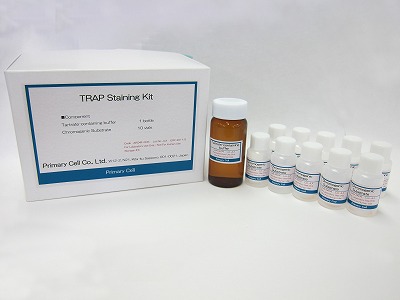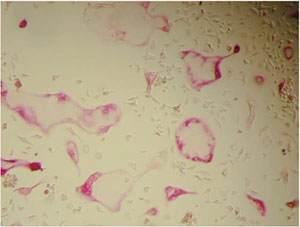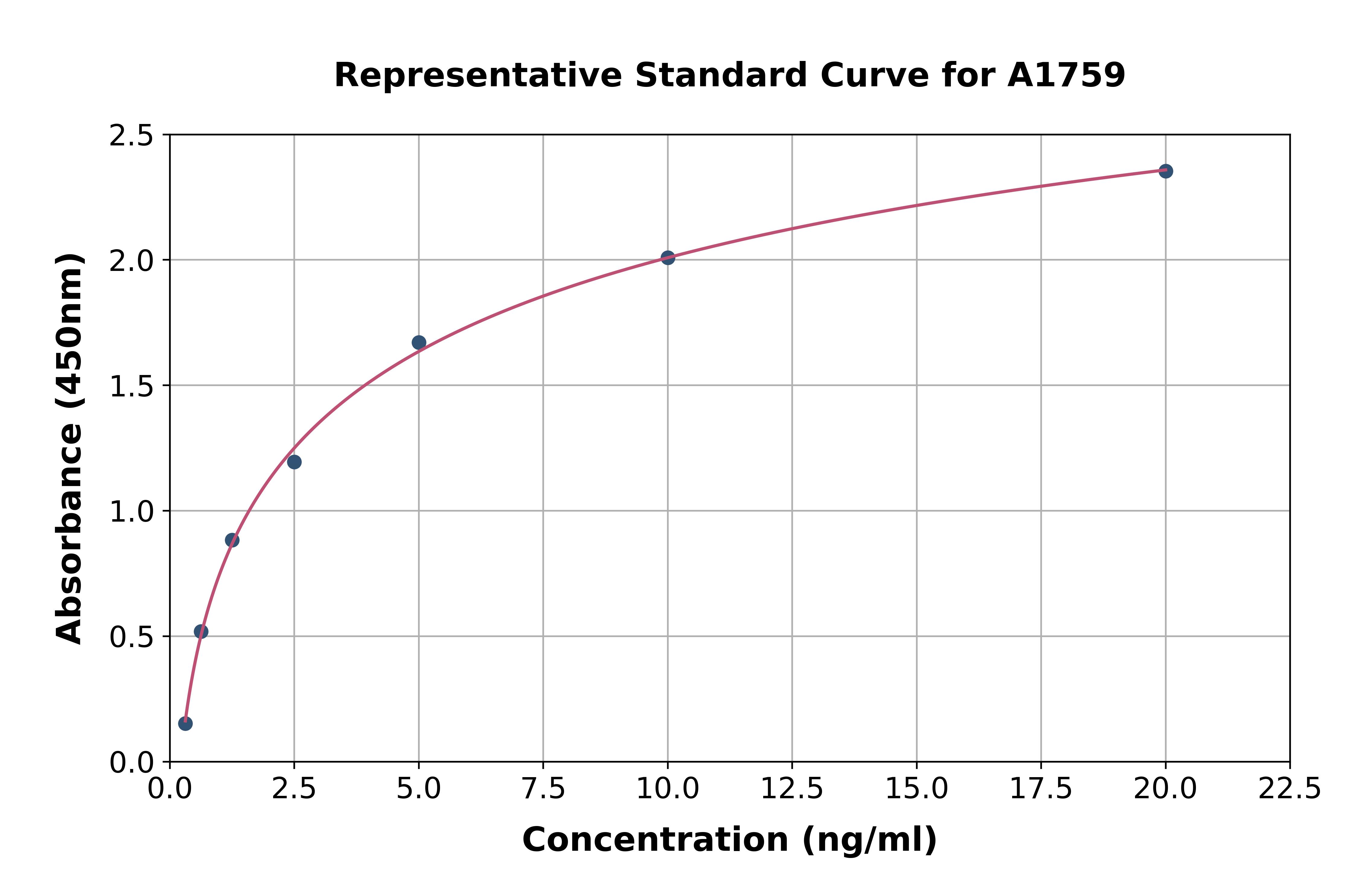
TRAP Staining Kit
PMC-AK04F
Product group Assays
Overview
- SupplierCosmo Bio USA
- Product NameTRAP Staining Kit
- Delivery Days Customer16
- CertificationResearch Use Only
- Scientific DescriptionThe TRAP Staining Kit (Cat.No.PMC-AK04F-COS) is used for the staining of Tartrate-Resistant Acid Phosphatase in osteoclasts. Bone mass is controlled by the balance between the activity of osteoblasts bone formation and the activity of osteoclasts. Alkaline phosphatase (ALP: ALP staining kit, Cat.No.PMC-AK20-COS) and tartrate-resistant acid phosphate are used as markers for osteoblasts and osteoclasts, respectively. Kit Components Tartrate-containing Buffer 50ml Chromogenic Substrate 10 Vials Note: Store at 4°C Protocol (96-well plate format): <ol> Remove culture medium. Wash each well once with 100 ul of PBS. Add 50 ul of the 10% Formalin Neutral Buffer Solution to each well and fix for 5 minutes at room temperature. Wash each well with 250 ul of deionized water. (x 3 times) Dissolve 1 vial of Chromogenic Substrate with 5 ml of Tartrate-containing Buffer. Add 50 ul of Chromogenic Substrates to each well. Incubate at 37°C for 20-60 minutes. Adjust incubation time until stained TRAP is clearly showing the result in figure 1. Wash with deionized water to stop the reaction. </ol> Note: Excess incubation will be cause of over staining. References 1) Sunao Takesita, Keisuke Kaji, Akira Kudo. Identification and Characterization of the New Osteoclast Progenitor with Macrophage Phenotypes Being Able to Differentiate into Mature Osteoclasts. JOURNAL OF BONE AND MINERAL RESEARCH Volume 15, Number 8 (2000). 1477-1488. (2) BEN A. A. SCHEVEN, JONE S. MILNE, SIMON P. ROBINS. A SEQUENTIAL CULTURE APPROACH TO STUDY OSTEOCLAST DIFFERENTIATION FROM NONADHERENT PORCINE BONE MARROW CELLS. In Vitro Cell. Dev. Biol. July-August (1998). Animal 34: 568-577. (3) Martha J. Somerman, Janice E. Berry, Zhila Khalkhali-Ellis, Philip Osdoby, Robert U. Simpson. Enhanced Expression of alpha v Integrin Subunit and Osteopontin during Differentiation of HL-60 Cells along Monocytic Pathway. EXPERIMENTAL CELL RESEARCH 216, 335-341(1995). (4) Ichiro Itonaga, Afsie Sabokbar, Susan D. Neale, Nicholas A. Athanasou. 1,25-Dihydroxyvitamin D3 and Prostaglandin E2 Act Directly on Circulating Human Osteoclast Precursors. Biochemical and Biophysical Research Communications 264, 590-595(1999). (5) Hiroshi Takayanagi, Kouetsu Ogasawara, Shigeaki Hida, Tomoki Chiba, Shigeo Murata, Kojiro Sato, Akinori Takaoka, Taeko Yokochi, Hiromi Oda, Keiji Tanaka, Kozo Nakamura and Tadatsugu Taniguchi. T-cell-mediated regulation of osteoclastogenesis by signaling cross-talk between RANKL and IFN- alpha Nature, Vol. 408, No.6812, 600-605, 30 November 2000. (6) Morinobu, A., Biao, W., Tanaka, S., Horiuchi, M., Jun, L., Tsuji,G., Sakai, Y., Kurosaka, M., Kumagai, S. (-)-Epigallocatechin-3-Gallate Suppresses Osteoclast Differentiation and Ameliorates Experimental Arthritisv in Mice. Arthritis Rheum. 58, 2012-2018 (2008) (7) Hase, H., Kanno, Y., Kojima, H., Sakurai, D., Kobata, T. Coculture of Osteoclast Precursors With Rheumatoid Synovial Fibroblasts Induces Osteoclastogenesis via Transforming Growth Factor beta-Mediated Down-Regulation of Osteoprotegerin. Arthritis Rheum. 58, 3356-3365 (2008) (8) Cao, H., Kuboyama, N. A Biodegradable Porous Composite Scaffold of PGA/beta-TCP for Bone Tissue Engineering. Bone. 46, 386-395 (2010) (9) Okada, Y., Hamada, N., Kim, Y., Takahashi, Y., Sasaguri, K., Ozono, S., Sato, S. Blockade of Sympathetic beta-receptors Inhibits Porphyromonas Gingivalis-induced Alveolar Bone Loss in an Experimental Rat Periodontitis Model. Arch. Oral Biol. 55, 502-508 (2010) (10) Okamoto, A., Ohnishi, T., Bandow, K., Kakimoto, K., Chiba, N., Maeda, A., Fukunaga, T., Miyawaki, S., Matsuguchi, T. Reduction of Orthodontic Tooth Movement by Experimentally Induced Periodontal Inflammation in Mice. Eur. J. Oral Sci. 117, 238-247 (2009) Frequently Asked Questions Question Is the Kit recommended for paraffin-embedded tissue use? Answer Unfortunately, we do not have experience using the kit with paraffin-embeeded tissue. However, samples fixed with Formalin are unable to be stained. Question On the datasheet, it is indicated that the kit is capable of staining 10 x 96-well plates. Could you please tell me the procedures when using a 6-well plate? Answer Please use 30 times more reagent compared to when using the 96-well plate. For example the amount of coloring agent per well will be 1.5ml. Question Will staining of macrophages be positive with the kit staining? Answer Yes, macrophages will stain positive too. Question When carrying out immunofluorescence, can the kit be used together? If possible, please let us know the protocol. Answer We do not have any experience using the kit with immunofluorescence, however it may be possible, thus we kindly ask you to try it out. Unfortunately, we can not guarantee results. Question How long can the chromogenic substrate solution be kept at 4C once dissolved? Answer Unfortuantely, Chromogenic substrate cant be stored after dissolution. Because it should be prepared prior to carrying out the experiment, chromogenic substrate is supplied at small units of 3mg in 10 vials. Question Do you offer a smaller size kit for this product? Answer Unfortunately no.
- UNSPSC41116133



